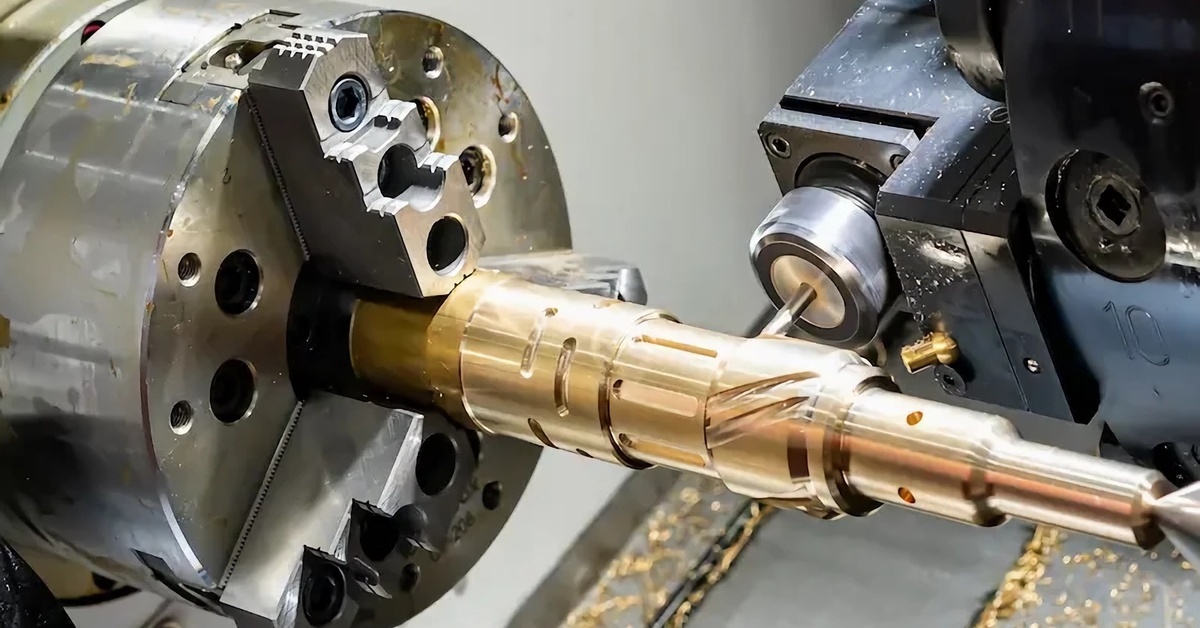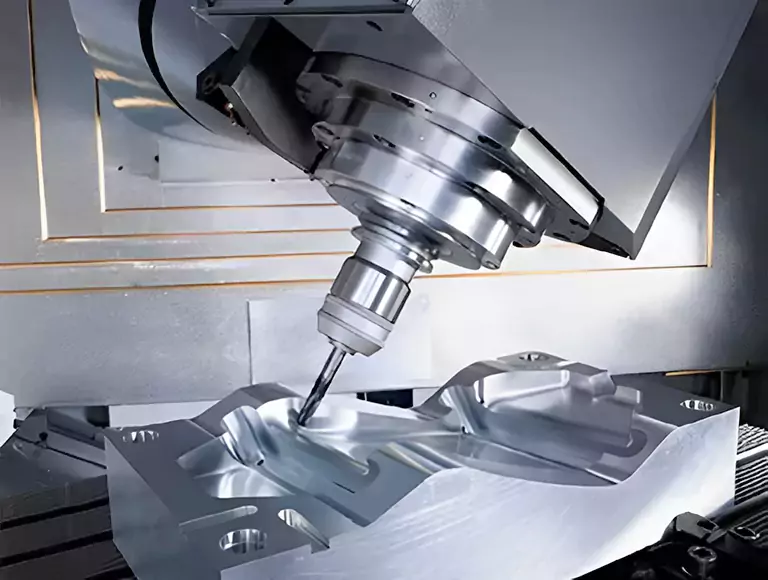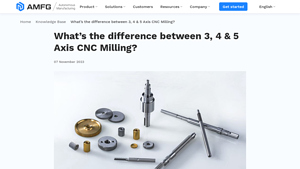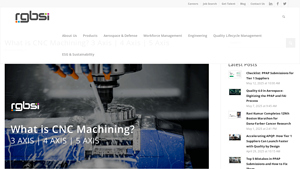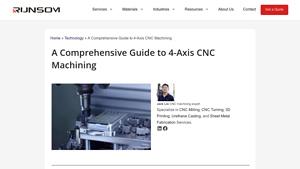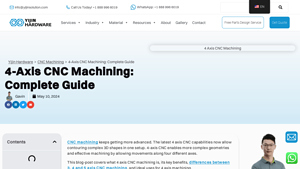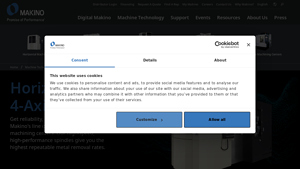4 Axis Machining Guide: Type, Cost, Top List…
Introduction: Navigating the Global Market for 4 axis machining
In today’s rapidly evolving manufacturing landscape, sourcing reliable 4-axis machining solutions presents a critical challenge for international B2B buyers. As industries increasingly demand precision-engineered components capable of meeting intricate geometrical specifications, understanding the nuances of 4-axis CNC machining becomes paramount. This guide offers an in-depth exploration of 4-axis machining, addressing various aspects such as types of machines, applications across diverse sectors, effective supplier vetting processes, and cost considerations.
With a focus on the unique needs of B2B buyers from Africa, South America, the Middle East, and Europe—including markets like Vietnam and Nigeria—this guide is crafted to empower decision-makers. By providing actionable insights and practical strategies, it enables manufacturers to navigate the complexities of sourcing not only the right machinery but also establishing fruitful supplier relationships.
The comprehensive nature of this resource aims to streamline purchasing processes, ensuring that businesses can effectively leverage the capabilities of 4-axis machining to enhance production efficiency and product quality. Engage with this guide to unlock the potential of advanced machining technologies and make informed procurement decisions that drive operational success in the global marketplace.
Understanding 4 axis machining Types and Variations
| Type Name | Key Distinguishing Features | Primary B2B Applications | Brief Pros & Cons for Buyers |
|---|---|---|---|
| 4-Axis Milling | Utilizes A-axis rotation for machining at varied angles. | Aerospace components, automotive parts | Pros: Versatile; enhances design capability. Cons: Higher initial setup costs. |
| 4-Axis Lathes | Combines rotating spindle and workpiece for turning operations. | Manufacturing intricate symmetrical components. | Pros: Ideal for complex geometries; efficient for mass production. Cons: Requires skilled operators. |
| 4-Axis Routers | Specializes in large part machining, particularly in wood. | Furniture manufacturing, cabinetry, signage. | Pros: High precision; efficient workflow. Cons: Limited geometrical options in some designs. |
| 4-Axis Laser Cutters | Uses laser technology for cutting with A-axis rotation. | Electronics, signage, and precision part cutting. | Pros: Exquisite detail; minimal waste. Cons: Equipment can be expensive. |
| 4-Axis Waterjet Cutters | Utilizes high-pressure water for cutting, adaptable to many materials. | Aerospace, automotive, and intricate designs. | Pros: Versatile across materials; no thermal distortion. Cons: Slower process compared to lasers for certain tasks. |
What are the Key Characteristics of 4-Axis Milling Machines?
4-axis milling machines incorporate an additional rotational axis, allowing flexible approaches to machining. They excel in crafting complex geometries, improving design capabilities beyond standard 3-axis machines. Ideal for industries like aerospace and automotive, where precision and intricate parts are in demand, buyers should consider the initial investment and setup costs against their expected production efficiency. Businesses must also account for potential training needs for skilled operators in their budgeting.
How Do 4-Axis Lathes Enhance Manufacturing Processes?
4-axis lathes add a layer of rotational versatility that traditional lathes lack, allowing for advanced turning operations on complex symmetrical components. They are perfect for creating intricate parts where dimensional precision is critical in manufacturing workflows. Businesses often turn to 4-axis lathes for high-volume production, but it’s essential to ensure operators are adequately trained. The trade-off for improved design capability and efficiency is a higher investment in both equipment and skilled personnel.
Are 4-Axis Routers Suitable for High-Volume Production?
4-axis routers are particularly well-suited for woodworking industries, where they offer the ability to machine large components with accuracy. Their design is beneficial for furniture production, cabinetry, and signage, allowing businesses to meet diverse customer needs efficiently. While they provide high efficiency and workflow adaptability, companies should assess their capacity for dealing with geometrical limitations, especially when considering complex designs that might require advanced alternatives.
What Can Businesses Expect from 4-Axis Laser Cutters?
4-axis laser cutters leverage precision laser technology alongside the A-axis rotation to produce detailed cuts on various materials. They are highly sought after in electronics and signage industries due to their accuracy and minimal waste generation during operations. Businesses should weigh the initial equipment investment against potential long-term efficiencies and the quality assurance benefits, keeping in mind that operational training and maintenance could influence overall costs.
How Do 4-Axis Waterjet Cutters Stand Out in Various Applications?
4-axis waterjet cutters are a versatile choice for precision cutting, commonly applied in sectors such as aerospace and automotive. They operate without generating heat that could affect material properties, making them suitable for a wide range of materials. When evaluating waterjet technology, organizations should consider the slower cutting speeds compared to laser options, balanced against the ability to handle complex designs and reduce material waste effectively.
Key Industrial Applications of 4 axis machining
| Industry/Sector | Specific Application of 4 Axis Machining | Value/Benefit for the Business | Key Sourcing Considerations for this Application |
|---|---|---|---|
| Aerospace Industry | Manufacturing turbine engine components | High precision and faster production of complex geometries | Certifications (e.g., AS9100), materials compatibility, and lead times |
| Automotive Industry | Production of engine blocks and transmission cases | Increased efficiency in producing multi-faceted designs | Tooling costs, setup efficiency, and flexibility in design changes |
| Electronics Industry | Fabrication of circuit board housings | Cost reduction through streamlined production and improved accuracy | Material sourcing for different electronic components, compliance with standards |
| Oil and Gas Industry | Machining durable valve bodies | Creation of robust components that withstand extreme conditions | Supplier reliability, quality assurance practices, and delivery schedules |
| Heavy Machinery Sector | Production of construction equipment parts | Ability to manufacture large and intricate designs with precision | Supplier experience in heavy-duty materials, machine setup capabilities, and maintenance support |
What Are the Key Applications of 4-Axis Machining in the Aerospace Industry?
In the aerospace sector, 4-axis machining is critical for manufacturing complex components such as turbine engines. The technology allows for the precise production of intricate geometries required for engine performance while minimizing lead times. Buyers from developing regions need to ensure suppliers have relevant certifications, such as AS9100, to meet industry quality standards while considering material compatibility and reliable lead times.
How Does 4-Axis Machining Benefit the Automotive Industry?
4-axis machining plays a significant role in the automotive industry, where it is employed for producing engine blocks and transmission cases. This capability enables manufacturers to produce multi-faceted components efficiently, reducing cycle times and lowering overall production costs. International B2B buyers should prioritize efficient setup processes and tooling costs while seeking flexibility in design adjustments to remain competitive.
Why Is 4-Axis Machining Essential for Electronics Manufacturing?
Within the electronics sector, 4-axis machining is utilized to create precision parts, such as circuit board housings. The ability to produce these intricate components with high accuracy leads to significant cost reductions and improved product performance. Sourcing considerations for foreign buyers should include ensuring compliance with industry standards and evaluating material sourcing options for various electronic components, considering both cost and quality.
What Are the Advantages of 4-Axis Machining in the Oil and Gas Sector?
In the oil and gas industry, 4-axis machining is vital for fabricating durable valve bodies and other critical components. These parts must withstand extreme pressures and corrosion rates, making precision machining essential. B2B purchasers should focus on the reliability of suppliers, their quality assurance practices, and the adherence to stringent delivery schedules, as delays can significantly impact operations.
How Does 4-Axis Machining Enhance Production in the Heavy Machinery Sector?
4-axis machining enhances the production of complex parts in the heavy machinery sector, such as components for construction equipment. The technology allows for the creation of large and intricate designs that maintain precision, critical for durability and functionality. Buyers should assess suppliers’ experience with heavy-duty materials, machine setup capabilities, and ongoing maintenance support to ensure optimal performance and longevity of the manufactured parts.
3 Common User Pain Points for ‘4 axis machining’ & Their Solutions
Scenario 1: Managing High Setup Costs for 4-Axis Machining Projects
The Problem:
Many B2B buyers in manufacturing often encounter a significant financial barrier when investing in 4-axis machining. The cost of purchasing and setting up a new 4-axis CNC machine can be substantial, particularly for small to medium-sized enterprises in regions like Africa and South America where budgets are often tight. Buyers may feel overwhelmed by the initial investment, which can limit their ability to transition from 3-axis to 4-axis machining, stunting growth and innovation potential.
The Solution:
To mitigate high setup costs, buyers should explore financing options such as leasing machinery rather than purchasing it outright. This allows for reduced upfront costs while still gaining access to advanced machinery capabilities. Additionally, it can be beneficial to work with suppliers that offer consolidated shipping and setup services, thereby cutting down shipping costs by sourcing all required components from one supplier. Furthermore, collaborative purchasing groups could be formed with other local businesses to share resources and reduce the investment burden. Continually assess total cost of ownership (TCO) by analyzing long-term savings in production efficiency and quality improvements that 4-axis machines can offer over time.
Scenario 2: Skill Shortages in Operating 4-Axis CNC Machines
The Problem:
A common challenge faced by manufacturers is the skill gap in operatives who can efficiently handle and program 4-axis CNC machines. As these machines require a higher level of expertise than their 3-axis counterparts, the gap in skilled labor can lead to inefficiencies, errors, and increased costs. Buyers in manufacturing sectors such as automotive and aerospace may struggle to find qualified professionals, affecting production timelines and product quality.
The Solution:
Investing in training programs for existing employees can be a game changer. Companies can partner with vocational schools or online education platforms that specialize in CNC programming and operation to upskill their workforce. Additionally, consider implementing mentorship programs where experienced machinists can share their knowledge with younger team members. Another strategy is to invest in user-friendly CNC software that requires less expertise to operate, which can help bridge the skills gap until workers gain the necessary experience. Including a detailed training requirement as part of the machine purchase agreement may also encourage vendors to provide necessary training support.
Scenario 3: Navigating Complex Design Requirements for 4-Axis Machining
The Problem:
When transitioning to 4-axis machining, buyers frequently encounter design complexities that are not as straightforward as anticipated. The ability to create complex geometries and parts introduces new challenges in design optimization. Buyers may find that their existing designs, suitable for 3-axis machining, need significant modifications to leverage the full capabilities of 4-axis machining, leading to frustration and delays.
The Solution:
Companies should prioritize collaboration between design and machining teams early in the development process. Utilizing advanced CAD/CAM software is essential for simulating how designs will be executed on a 4-axis machine to identify potential issues before production. Engaging with experienced CNC programmers during the design phase can lead to adjustments that enhance manufacturability without compromising design intent. Another proactive approach is participating in workshops or webinars focused on 4-axis machining design principles, where industry experts can share valuable insights and best practices. Buyers may also benefit from establishing long-term relationships with machining service providers who can provide ongoing feedback on design feasibilities based on their operational insights.
Strategic Material Selection Guide for 4 axis machining
What Materials are Most Suitable for 4-Axis Machining?
When considering material selection for 4-axis machining, it’s essential to evaluate characteristics that influence manufacturing efficiency and end-product performance. Below are three common materials often utilized in this process, along with a comprehensive analysis of their respective properties, advantages, and challenges for international B2B buyers.
What Are the Key Properties and Advantages of Aluminum in 4-Axis Machining?
Aluminum is a widely utilized material in 4-axis machining, celebrated for its lightweight properties and excellent machinability. With a high strength-to-weight ratio, aluminum alloys can perform well under moderate temperature conditions, typically resisting temperatures up to 150°C (302°F). Its corrosion resistance, particularly in marine and industrial environments, enhances longevity and autonomy in various applications.
Pros: Aluminum’s relative affordability and its adaptability to complex geometries make it a favored choice for industries like aerospace and automotive. Its excellent thermal and electrical conductivity further empowers its use in electronics and heat exchangers.
Cons: However, aluminum can be softer than other metals, making it susceptible to scratching and deformation under certain stresses. Additionally, it may require surface treatments to prevent oxidization, which could increase manufacturing complexity.
How Does Stainless Steel Perform in 4-Axis Machining Applications?
Stainless steel is another prevalent choice for manufacturing through 4-axis machining, especially when durability, corrosion resistance, and high strength are necessary. Able to withstand high temperatures and pressures, stainless steels—especially those in the 300 series—are suitable for applications requiring exposure to harsh chemicals.
Pros: Stainless steel’s ruggedness makes it ideal for medical devices, food processing equipment, and marine applications. Its durability and aesthetic appeal can enhance product longevity and marketability.
Cons: While robust, stainless steel is more difficult to machine compared to aluminum. Higher manufacturing costs and increased wear on tooling can be additional concerns.
What Are the Benefits and Challenges of Plastics Like Polycarbonate in 4-Axis Machining?
Plastics such as polycarbonate bring unique advantages to the 4-axis machining landscape. Known for outstanding impact resistance and transparency, polycarbonate offers weight savings with thermal stability, rendering it suitable for countless applications from automotive components to consumer electronics.
Pros: Its ease of machining at lower speeds than metals results in reduced tooling wear, and its versatility allows for intricate designs without significant additional costs.
Cons: On the downside, plastics can be sensitive to UV light and temperature, potentially limiting their application lifespan if not properly formulated or treated. The strength of polycarbonate, while adequate for many uses, does not match that of metals, making it unsuitable for heavy-load applications.
What Should International Buyers Consider When Choosing Materials for 4-Axis Machining?
When sourcing materials for 4-axis machining, B2B buyers from diverse regions, including Africa, South America, the Middle East, and Europe, need to consider compliance with international standards such as ASTM, DIN, and JIS. Cost, availability, and regional supply chain stability are also vital factors. For example, material highs can fluctuate based on local market conditions and logistical challenges. Understanding regional preferences and ensuring quality control aligned with local regulations will facilitate smoother transactions.
| Material | Typical Use Case for 4-axis machining | Key Advantage | Key Disadvantage/Limitation | Relative Cost (Low/Med/High) |
|---|---|---|---|---|
| Aluminum | Aerospace and automotive components | Lightweight with excellent machinability | Susceptible to scratching and deformation | Medium |
| Stainless Steel | Medical devices and food processing equipment | High strength and corrosion resistance | Higher machining costs and tooling wear | High |
| Polycarbonate | Consumer electronics and automotive parts | Impact resistant and easy to machine | Sensitive to UV and temperature | Low |
This analysis provides a concise overview of material selection for 4-axis machining, aiming to guide B2B buyers in making informed decisions tailored to their specific operational needs.
In-depth Look: Manufacturing Processes and Quality Assurance for 4 axis machining
Understanding the intricacies of manufacturing processes and quality assurance (QA) for 4-axis machining is vital for B2B buyers aiming to invest in advanced manufacturing technologies. This knowledge is especially crucial for international buyers looking to collaborate with reliable suppliers. The following content outlines the typical stages of manufacturing and the key quality assurance measures necessary for ensuring that 4-axis machined products meet both design specifications and regulatory standards.
What Are the Typical Manufacturing Processes in 4-Axis Machining?
The manufacturing process for 4-axis machining can be segmented into several stages: material preparation, forming, assembly, and finishing. Each of these steps plays a central role in ensuring that the end product meets the required specifications.
How Is Material Prepared for 4-Axis Machining?
Material preparation is the foundational step for any machining operation. It entails selecting the right type of material based on the intended application, which could include metals, plastics, or composites.
-
Material Selection: B2B buyers should be aware of the material type, as it affects machining capabilities and the final performance of the component. Industries such as aerospace and automotive typically use high-strength materials like aluminum or titanium, while electronic components may require precision machined plastics.
-
Blank Preparation: The material is often cut to size to create a blank. This involves sawing or shearing processes to ensure that only minimal machining will be necessary during the actual 4-axis operation.
-
Surface Treatments: Depending on the chosen material, surface treatments such as deburring, polishing, or applying protective coatings may be necessary to enhance workability and performance.
What Are the Key Techniques Used in Forming?
Once the materials are prepared, the forming stage employs various techniques to convert the raw materials into precise and complex components.
-
CNC Programming: Before machining begins, the creation of a Computer-Aided Manufacturing (CAM) program is essential. This program defines the machining path, tool selection, and operational parameters based on the design input provided via Computer-Aided Design (CAD) software.
-
Machining Operation: During the machining process, the CNC machine executes the programmed paths, moving along the X, Y, and Z axes while also rotating the workpiece around the A axis. This simultaneous movement allows for intricate shapes and angles that simply cannot be produced with 3-axis machines.
How is Assembly Conducted in 4-Axis Machining?
In many cases, the parts produced through 4-axis machining may require additional assembly, especially in sectors like automotive or aerospace.
-
Sub-Assembly: Some components may need to be assembled with other parts to create sub-assemblies. This process may involve riveting, welding, or using threaded fasteners to form a complete unit.
-
Final Assembly: The final assembly stage combines the sub-assemblies into the overall product. For instance, in the automotive industry, this could mean integrating machined engine components into a chassis.
What Finishing Techniques Are Commonly Used in 4-Axis Machining?
Finishing is crucial for achieving the desired tolerances and surface qualities that meet customer specifications.
-
Deburring and Cleaning: Post-machining, parts need to be deburred to remove sharp edges and any irregularities. Cleaning ensures that no contaminants affect the product’s performance.
-
Surface Finishing: Techniques such as anodizing, painting, or plating might be employed to enhance the aesthetic and functional properties of the finished part.
What Are the Quality Assurance Measures for 4-Axis Machining?
Quality assurance is indispensable in the 4-axis machining process. B2B buyers must understand various QA standards and checkpoints to ensure that their suppliers adhere to the international quality norms.
What Are the Relevant International Standards for QA?
Adhering to international standards like ISO 9001 is often a prerequisite for suppliers in the manufacturing sector. This certification assures that organizations maintain a consistent quality management system, thus enhancing customer satisfaction.
- Industry-Specific Certifications: Depending on the target market, suppliers may also need to comply with industry-specific standards such as CE marking for European markets or API certifications for the oil and gas sector.
What Are the Key Quality Control Checkpoints?
Implementing quality control (QC) is vital for maintaining the integrity of the manufacturing process. Common QC checkpoints include:
-
Incoming Quality Control (IQC): This involves inspecting the raw materials and components before they enter the production process, ensuring they meet specific requirements.
-
In-Process Quality Control (IPQC): Monitoring occurs during machining to catch any deviations from the defined parameters. This can include real-time measurement of tolerance and surface finish requirements.
-
Final Quality Control (FQC): Once manufacturing is complete, a thorough inspection of the finished parts occurs. This may involve dimensional checks, surface finish evaluations, and function testing against the design specifications.
How Can B2B Buyers Verify Supplier Quality Assurance?
B2B buyers should establish a robust plan for verifying the quality assurance processes of their suppliers. Here are some effective strategies:
-
Supplier Audits: Conduct periodic audits of suppliers’ facilities and processes to review their adherence to quality management standards. This should include evaluating their documentation, processes, and facilities.
-
Receiving Inspection Reports: Request detailed inspection reports that outline the QC measures taken and the results obtained. These records provide insights into the consistency and quality of the components.
-
Third-Party Inspections: Engaging third-party inspection services can add an additional layer of reliability, ensuring impartial assessments of the supplier’s products.
How Do Quality Control and Certification Nuances Affect International B2B Buyers?
For international B2B buyers, especially those operating across regions like Africa, South America, the Middle East, and Europe, understanding the nuances of QC and certification requirements is critical.
-
Diverse Regulations: Different countries may have varying regulatory requirements. International buyers must ensure their chosen suppliers comply with both local and international standards.
-
Logistical Considerations: Quality control measures impacting logistics, such as shipping and handling procedures, should be understood in advance to avoid delays and additional costs.
-
Cultural Sensitivities: Engaging with suppliers from diverse regions may require an understanding of local customs and practices related to quality assurance processes.
By thoroughly understanding the manufacturing processes and emphasizing quality assurance, B2B buyers will be well-equipped to foster relationships with suppliers that enhance their operational efficiency and product reliability.
Practical Sourcing Guide: A Step-by-Step Checklist for ‘4 axis machining’
To aid B2B buyers in successfully procuring 4-axis machining services, this checklist details essential steps, ensuring a streamlined and effective sourcing process. Whether you are in Africa, South America, the Middle East, or Europe, understanding these key actions will facilitate informed decision-making and lead to better procurement outcomes.
Step 1: Define Your Technical Specifications
Begin by clearly articulating your project requirements, including dimensions, tolerances, and materials needed. This foundational step is vital for communicating with potential suppliers effectively and ensures they understand the complexity and nuances of your project.
– Material Requirements: Specify any particular material characteristics that are necessary, such as hardness or compliance with industry standards.
– Precision Levels: Detail the tolerances you require, as this will guide your supplier selection.
Step 2: Research and Shortlist Potential Suppliers
Conduct thorough research to identify suppliers with expertise in 4-axis machining. A robust shortlist will increase your chances of finding a partner who can meet your technical needs efficiently.
– Industry Experience: Look for suppliers with a proven track record in your industry, as they will be more familiar with specific challenges and standards.
– Capacity & Capability: Assess their production capacity to ensure they can handle your project’s scale without compromising quality.
Step 3: Evaluate Supplier Certifications and Quality Standards
Before committing, validate that suppliers possess relevant certifications and maintain high-quality standards. This step minimizes risks associated with subpar quality that could lead to costly errors in production.
– ISO Certifications: Seek out ISO 9001 or similar certifications, which indicate a commitment to quality management practices.
– Process Controls: Inquire about their quality control processes, such as regular audits and inspection protocols.
Step 4: Request Detailed Proposals
Once you’ve shortlisted suppliers, request comprehensive proposals that include pricing, lead times, and terms of service. This allows for a clear comparison of what each supplier is offering and helps to identify potential discrepancies.
– Breakdown of Costs: Ensure proposals include detailed cost estimations—material, labor, tooling, and shipping—to avoid hidden fees later on.
– Timeline Clarity: Confirm expected lead times and how they align with your project deadlines.
Step 5: Conduct Factory Audits or Visits
If feasible, visit potential suppliers’ facilities to evaluate their production environment firsthand. This is critical for assessing their capabilities and gauging their level of professionalism and operational efficiency.
– Equipment Checks: Inspect their machinery and technology to ensure they are using modern, well-maintained 4-axis CNC machines.
– Workflow Evaluation: Observe their production workflows and quality control processes to assess operational effectiveness.
Step 6: Seek Client References and Case Studies
Ask for references or case studies from client projects similar to yours. Direct feedback from past customers can provide invaluable insights into suppliers’ reliability and performance.
– Success Stories: Look for examples that highlight their strengths in specific applications relevant to your needs.
– Feedback on Collaboration: Understand their communication and project management practices through the eyes of other clients.
Step 7: Negotiate Terms and Finalize Contracts
Finally, engage in negotiations to secure the best possible terms. Clearly outline all conditions, including delivery schedules, payment terms, and warranties.
– Legal Review: Have all documentation reviewed by legal professionals to ensure compliance with local and international laws.
– Flexibility in Terms: Discuss possibilities for adjustments based on project evolution, ensuring both parties have a clear understanding of expectations.
By following these steps diligently, you will position yourself to select the ideal supplier for your 4-axis machining needs, setting the stage for a successful partnership that enhances your production capabilities.
Comprehensive Cost and Pricing Analysis for 4 axis machining Sourcing
What Are the Key Cost Components in 4 Axis Machining?
Understanding the cost structure of 4-axis machining is essential for optimizing supply chain decisions. The primary cost components include:
-
Materials: The type of materials significantly impacts the machining cost. Common materials used in 4-axis machining include metals, plastics, and composites. Each material has its own associated cost, influenced by market rates, availability, and specific material properties required for the final product.
-
Labor: Skilled labor is necessary for operating 4-axis CNC machines. The complexity of setup, programming, and supervision increases labor costs. Companies can mitigate these costs by investing in cross-training employees and optimizing machine utilization.
-
Manufacturing Overhead: This encompasses fixed and variable costs associated with facility operations, including utilities, equipment maintenance, and depreciation. Efficient facility layout and process optimization can lower overhead costs.
-
Tooling: Specialized cutting tools for 4-axis machining are critical for achieving precision. Tooling costs can vary based on the complexity of designs and the material being machined. Investing in high-quality tooling can lead to longer tool life and better machining efficiency.
-
Quality Control (QC): Ensuring the machined parts meet the required specifications necessitates rigorous QC processes. Implementing efficient QC protocols can reduce rework and scrap costs, which are essential in sustaining profitability.
-
Logistics: The costs of transporting raw materials to the facility and finished products to customers can vary widely based on distance, volume, and mode of transport. Establishing reliable logistics partnerships is crucial for managing these costs effectively.
-
Margin: The expected profit margin can vary depending on market competition, economies of scale, and overall service offerings. A clear understanding of margin expectations can help buyers negotiate more effectively.
How Do Price Influencers Affect 4 Axis Machining Costs?
Several factors influence the pricing framework for 4-axis machining:
-
Volume and Minimum Order Quantity (MOQ): Suppliers often provide discounts for larger orders. Buyers should analyze their projected demand to decide on optimal order quantities that balance cost savings with storage capabilities.
-
Specifications and Customization: Unique designs and complex geometries will generally increase costs due to additional setup time and tooling requirements. Buyers should assess the necessity of complex features against budget constraints.
-
Material Choices: The selection of premium materials will directly affect costs. For instance, aerospace-grade aluminum is significantly more expensive than standard steel. Weight, strength, and durability specifications should guide material selection based on the intended application.
-
Quality and Certification Requirements: Parts designed for critical applications such as aerospace or medical must comply with stringent certification standards, which can lead to higher costs due to enhanced QC requirements.
-
Supplier Factors: Supplier reputation, experience, and capabilities can affect pricing. Seasoned suppliers might charge more due to high-quality assurance and efficient processes, while newer companies might offer lower prices to compete.
-
Incoterms: The agreed shipping terms (Incoterms) significantly influence logistics costs. For instance, EXW (Ex Works) indicates the buyer assumes all transportation costs from the seller’s dock, while DDP (Delivered Duty Paid) means the seller bears these costs, affecting the pricing structure.
What Are Effective Buyer Tips for Reducing Costs in 4 Axis Machining?
Buyers looking to optimize costs in 4-axis machining should consider the following strategies:
-
Effective Negotiation: Engage in negotiations with suppliers by presenting clear demands related to MOQ, pricing, and other critical factors. Leveraging long-term partnerships may yield better terms.
-
Focus on Cost Efficiency: Explore options for off-peak production or bulk purchasing to lower operational costs. Utilize value engineering principles to assess designs for manufacturability, which can lead to cost reductions.
-
Evaluate Total Cost of Ownership (TCO): Look beyond upfront prices; estimate long-term costs associated with maintenance, downtime, and quality failures. Comparing TCO across suppliers can highlight cost-effective options.
-
Be Aware of International Pricing Nuances: When sourcing from regions like Africa, South America, the Middle East, and Europe, consider currency fluctuations, trade agreements, and export/import tariffs, which can all affect pricing.
In conclusion, a comprehensive understanding of cost components, price influencers, and practical buyer strategies can significantly enhance the purchasing process of 4-axis machining services. Potential buyers should conduct thorough market analysis and supplier due diligence to achieve optimal pricing and quality outcomes.
Alternatives Analysis: Comparing 4 axis machining With Other Solutions
Understanding Alternatives to 4 Axis Machining
As industries evolve, manufacturers continually seek the most effective methods for machining complex parts. While 4-axis machining serves many applications well, it is crucial for B2B buyers to evaluate alternatives that may better suit their specific requirements. This section compares 4-axis machining with two viable alternatives: 3-axis machining and 5-axis machining, covering performance, cost, ease of implementation, maintenance, and best use cases.
Comparison Table
| Comparison Aspect | 4 Axis Machining | 3 Axis Machining | 5 Axis Machining |
|---|---|---|---|
| Performance | High precision for complex parts with rotational features. | Good for simple, flat geometries but limited for complex features. | Exceptional for complex geometries and multi-directional cutting. |
| Cost | Moderate initial investment, but cost-effective with advanced features. | Generally lower capital cost and operating expenses. | Higher investment due to advanced technology and additional complexity. |
| Ease of Implementation | Requires skilled operators and setup. Ideal for batch runs. | Easier to set up and operate with fewer requirements. | Complex setup requiring specialized knowledge and programming. |
| Maintenance | Requires regular maintenance due to complexity. | Easier to maintain with fewer moving parts. | High maintenance due to advanced technology and moving components. |
| Best Use Case | Aerospace and automotive for intricate components. | Simple parts and prototyping needs. | High-value parts needing extreme precision and complex shapes. |
What Are the Advantages and Disadvantages of Each Alternative?
What Are the Pros and Cons of 3 Axis Machining?
3-axis machining is perhaps the most widely used method for CNC machining, suitable for simple flat to 2.5D geometries. Its primary advantage is its affordability, making it an excellent choice for businesses looking for lower initial investments. It is relatively straightforward to implement and requires minimal operator training. However, it has significant limitations: 3-axis machines cannot effectively manage features requiring complex angles, often needing multiple setups, which can hinder efficiency for intricate designs.
How Does 5 Axis Machining Compare?
5-axis machining offers an advanced solution, allowing movement across 5 axes simultaneously, providing unmatched capability to manufacture highly complex shapes in a single setup. This method is particularly advantageous in industries requiring high precision, such as aerospace and medical device manufacturing. However, this complexity does come at a cost. 5-axis machines represent a higher capital investment and ongoing maintenance, which may not be justifiable for smaller operations or simpler machining tasks. Skilled operators are essential to unlock the full potential of this technology.
How Can B2B Buyers Choose the Right Solution?
Determining the best machining technology hinges on analyzing specific business needs, including the complexity of parts, production volume, budget constraints, and available technical skills. For companies looking to produce intricate shapes with high precision at scale, 4-axis or even 5-axis machining could prove beneficial. Conversely, businesses focused on simpler components or lower volumes might find that 3-axis solutions suffice and provide cost savings. Ultimately, understanding the strengths and weaknesses of each option allows B2B buyers to select the most appropriate machining technology for their requirements.
Essential Technical Properties and Trade Terminology for 4 axis machining
When exploring 4-axis machining, understanding its essential properties and terminologies is crucial for effective decision-making in manufacturing. This section highlights critical specifications and trade terminology relevant to B2B buyers engaged in the procurement or utilization of 4-axis CNC machining services.
What are the Key Technical Properties of 4-Axis Machining?
1. Material Grade
The material grade refers to the specific type of material used for machining, such as aluminum, steel, or plastics. Different grades exhibit varying mechanical properties like tensile strength or ductility. For international buyers, knowing the appropriate material grade is essential for ensuring that finished parts meet specific industry standards, localized regulations, and performance requirements.
2. Tolerance
Tolerance specifies the acceptable deviation from a desired dimension, typically expressed in millimeters or micrometers. In 4-axis machining, maintaining precise tolerances is critical as it directly affects the part’s performance and fit in its end-use application. For B2B buyers, ensuring tight tolerances can prevent costly rework and delays in production cycles.
3. Surface Finish
Surface finish denotes the texture of the machined surface, which can range from rough to mirror-like finishes. The desired surface finish can impact both aesthetic appeal and functionality, such as improving flow characteristics in automotive components. Understanding the required surface finish helps buyers align their product expectations with machining capabilities.
4. Cut Depth
Cut depth refers to how deeply the tool cuts into the material during the machining process. Different applications may require varying cut depths, influencing the machining time and tool wear. B2B buyers should consider cut depth in conjunction with the material to ensure optimal processing efficiency and cost-effectiveness.
5. Feed Rate
Feed rate is the speed at which the workpiece moves past the cutting tool, typically expressed in units of distance per minute. A well-considered feed rate can enhance production efficiency while ensuring the precision and integrity of the machined part. B2B professionals need to align feed rate with their production timeline and quality requirements.
What are Common Trade Terms in 4-Axis Machining?
1. OEM (Original Equipment Manufacturer)
OEM refers to a company that manufactures products that may be marketed and sold by another company under its brand name. Understanding OEM relationships is vital for B2B buyers looking to ensure product quality and reliability, especially in sectors that demand high-performance standards like automotive and aerospace.
2. MOQ (Minimum Order Quantity)
MOQ defines the minimum amount of product a supplier is willing to sell, which can influence purchasing decisions. For buyers, especially those in emerging markets, identifying the MOQ can help in negotiating terms that match their production capabilities and market demand.
3. RFQ (Request for Quotation)
An RFQ is a document sent to suppliers to request pricing for specific services or products. In 4-axis machining, sending RFQs can ensure that buyers get a competitive and transparent pricing structure, enabling better budgeting and cost estimation for projects.
4. Lead Time
Lead time is the period from placing an order to the delivery of the product. Understanding the lead time for 4-axis machining services is crucial for planning production schedules and inventory management. B2B buyers should account for lead times when considering supply chain dynamics, particularly in high-volume industries.
5. Incoterms (International Commercial Terms)
Incoterms are international standards for shipping and logistics, outlining the responsibilities of buyers and sellers during delivery. Familiarity with Incoterms enables B2B buyers to mitigate risks associated with shipping costs, customs clearance, and transfer of ownership, ensuring smoother international transactions.
By grasping these technical properties and trade terms, decision-makers can make informed choices about their CNC machining projects, ultimately leading to improved product quality and operational efficiency.
Navigating Market Dynamics and Sourcing Trends in the 4 axis machining Sector
What Are the Key Trends Driving the 4-Axis Machining Market Today?
The global 4-axis machining market is witnessing transformative trends driven by technological advancements, the rise of automation, and increasing demand for precision manufacturing. As industries such as aerospace, automotive, and electronics evolve, the need for complex geometries and high precision continues to expand. For B2B buyers in regions like Africa, South America, the Middle East, and Europe, understanding the nuances of these trends is crucial for strategic sourcing decisions.
One significant trend is the surge in adopting advanced materials and techniques that enhance machining efficiency. Innovations like lightweight composites and high-speed machining are reshaping manufacturing landscapes, facilitating the production of intricate parts that were previously deemed impossible. Additionally, the integration of Industry 4.0 technologies—including IoT and data analytics—boosts operational efficiency and streamlines supply chains.
Another emerging trend is the increasing emphasis on cost-efficiency. B2B buyers are seeking suppliers who can deliver high-quality outcomes while remaining budget-conscious. The capability of 4-axis machines to reduce setup times by enabling multiple sides of a workpiece to be machined in one fixture presents a compelling advantage over conventional methods. Moreover, as global trade dynamics shift, suppliers who can demonstrate flexibility and responsiveness are more likely to attract international buyers.
How Is Sustainability Impacting Sourcing Decisions in the 4-Axis Machining Sector?
Sustainability and ethical sourcing are becoming paramount in the 4-axis machining sector. Buyers are increasingly aware of the environmental impact of their manufacturing choices, prompting a shift towards greener practices. For instance, using energy-efficient machines and optimizing machining processes can significantly reduce waste and energy consumption. Additionally, sourcing raw materials from sustainable suppliers not only enhances a company’s ethical standing but also often meets the expectations of a more environmentally conscious customer base.
B2B buyers are advised to seek certifications pertaining to sustainable manufacturing practices, such as ISO 14001 or LEED certification. These credentials indicate a supplier’s commitment to environmentally friendly practices and can provide a competitive edge in showcasing a company’s dedication to corporate social responsibility. Furthermore, opting for recycled materials or biocompatible components in manufacturing can promote sustainability in production, aligning with global efforts to reduce carbon footprints.
The implications of these sustainable practices extend beyond compliance; they resonate deeply with consumers, impacting brand reputation and loyalty. Suppliers focusing on sustainability are likely to see a preference from B2B buyers looking for long-term partnerships centered on ethical transparency and innovation.
What Is the Historical Context of 4-Axis Machining for B2B Buyers?
Understanding the historical context of 4-axis machining enriches the B2B sourcing landscape. The evolution of CNC (Computer Numerical Control) technology began in the 1950s, initially focusing on 2D machining. As sophistication progressed, 3-axis machining became the norm, allowing for increased complexity in part manufacturing. The introduction of the 4-axis system in the late 20th century marked a turning point, enabling manufacturers to create more intricate designs without the time and cost implications associated with multiple setups.
The evolution further accelerated in the 21st century with advancements in software and automation, significantly enhancing machine capabilities and control. This historical progression from basic to complex machining solutions reflects the broader trends in manufacturing, where the demand for versatility, efficiency, and precision is driving continual innovation. For B2B buyers, awareness of this evolution helps in understanding the capabilities of different suppliers and the technologies they employ, allowing for informed sourcing that aligns with both current needs and future manufacturing trends.
Frequently Asked Questions (FAQs) for B2B Buyers of 4 axis machining
-
1. How do I choose the right 4-axis machining supplier?
Selecting the right 4-axis machining supplier involves thorough research and consideration of several factors. Look for suppliers with a strong portfolio and proven experience in your specific industry. Assess their manufacturing capabilities, and check if they have advanced machinery, skilled operators, and quality control processes in place. Additionally, request client references and read reviews to evaluate customer satisfaction. Establish clear communication regarding project requirements and timelines to ensure that the supplier can meet your expectations. -
2. What materials can be machined using 4-axis CNC technology?
4-axis CNC machining is incredibly versatile and can handle various materials, including metals like aluminum, steel, and titanium; plastics like acrylic and polycarbonate; and wood. The choice of material typically depends on the specific application and the mechanical properties needed for the final product. Be sure to discuss your specific requirements with your supplier to ensure they can facilitate the machining of your chosen material, as different machines may have varying capacities and limitations. -
3. How does the MOQ (Minimum Order Quantity) affect my purchasing decision?
When sourcing 4-axis machining, understanding the MOQ set by suppliers is essential. MOQs vary widely depending on the supplier and project requirements. Some manufacturers may have low MOQ options ideal for prototyping or small production runs, while others may require larger quantities for cost-effectiveness. Consider your budget and project scale, and negotiate terms that work for your needs. Discussing your specific requirements may lead to flexibility in MOQ and better pricing arrangements. -
4. What payment terms should I expect from a 4-axis machining supplier?
Payment terms can vary significantly among suppliers, so it’s essential to clarify these upfront. Standard terms may include a percentage upfront, followed by the balance upon completion, or net 30/60 days post-delivery. For international transactions, consider currency exchange rates and possible additional fees. Always review the supplier’s payment policies thoroughly to avoid surprises and ensure that the terms align with your cash flow requirements. -
5. What quality assurance measures should I look for in a 4-axis machining provider?
Quality assurance (QA) is paramount in 4-axis machining. Look for suppliers that implement comprehensive QA processes, such as regular inspection and testing of materials and finished parts. ISO certifications or other internationally recognized standards can indicate a commitment to quality. Discuss their QA procedures, such as machining tolerances, testing methods, and any certifications they hold. A robust QA program ensures the final products meet your specifications consistently. -
6. How can I ensure timely delivery when sourcing 4-axis machining services?
To ensure timely delivery, establish clear timelines with your supplier before the project begins. Communicate your deadlines and any potential penalties for delays. It’s beneficial to choose suppliers who have a solid track record of timely deliveries and good project management practices. Additionally, inquire about their production capacity and scheduling flexibility, especially if any unforeseen issues arise during the production process. -
7. Are there customization options available in 4-axis machining?
Yes, customization is one of the significant advantages of 4-axis machining. Most suppliers can accommodate a range of custom specifications, including unique geometries, sizes, and finishes. It’s essential to provide detailed design specifications and discuss your requirements thoroughly with the supplier to ensure they can meet your needs. Utilizing CAD and CAM technologies can further enhance the customization process, allowing for intricate designs and precise replication. -
8. What are the logistics considerations when sourcing from international suppliers?
When sourcing 4-axis machining services from international suppliers, logistics can impact costs and delivery times. Consider aspects such as shipping methods, lead times, customs clearance, and duties. Collaborate with your supplier to determine the most efficient transport routes and select reliable freight forwarders with experience in your target markets. Be aware of possible regulatory requirements specific to your region, as these can influence the overall procurement process.
Important Disclaimer & Terms of Use
⚠️ Important Disclaimer
The information provided in this guide, including content regarding manufacturers, technical specifications, and market analysis, is for informational and educational purposes only. It does not constitute professional procurement advice, financial advice, or legal advice.
While we have made every effort to ensure the accuracy and timeliness of the information, we are not responsible for any errors, omissions, or outdated information. Market conditions, company details, and technical standards are subject to change.
B2B buyers must conduct their own independent and thorough due diligence before making any purchasing decisions. This includes contacting suppliers directly, verifying certifications, requesting samples, and seeking professional consultation. The risk of relying on any information in this guide is borne solely by the reader.
Top 6 4 Axis Machining Manufacturers & Suppliers List
1. 4th Axis Machine – CNC Machined Parts
Domain: 4thaxismachine.co
Registered: 2013 (12 years)
Introduction: 4th Axis Machine and Design, Inc. specializes in CNC machined parts and metal CNC manufacturing. They are a certified woman-owned small business (WOSB) and certified by the Women’s Business Enterprise National Council (WBENC) since 2023. The company has been a consistent supplier of NASA space flight hardware since 2015, working on projects such as the Roman Telescope, Europa Clipper, GOES R, VIPE…
2. AMFG – CNC Milling Machines: 3-Axis, 4-Axis, 5-Axis
Domain: amfg.ai
Registered: 2018 (7 years)
Introduction: CNC Milling Machines: 3-Axis, 4-Axis, and 5-Axis. Key Differences: 3-axis involves fixed cutting tool movement along X, Y, Z axes; 4-axis adds A-axis for rotational movement, enhancing efficiency and precision; 5-axis includes B and C axes for advanced rotational capabilities, allowing for multi-side machining without repositioning. Applications: 3-axis suitable for simple designs; 4-axis enhances…
3. RGBSI – CNC Machining Solutions
Domain: blog.rgbsi.com
Registered: 1997 (28 years)
Introduction: CNC (computer numerical control) machining is a manufacturing process where programmed computer software directs machinery motions for automation. It can perform various techniques like milling, water jet cutting, and laser cutting. CNC machines operate along multiple axes: 3-axis (XYZ plane), 4-axis (includes rotation around the X axis), and 5-axis (adds rotation around Y and Z axes). 3-axis mach…
4. Runsom – 4-Axis CNC Machining
Domain: runsom.com
Registered: 2011 (14 years)
Introduction: 4-axis CNC machining is an advanced machining technique that uses an extra rotating axis for handling multiple tasks and parts simultaneously. It is capable of milling intricate parts at unusual angles and often saves time by reducing the need for multiple setups. The machines can be classified into two main categories: Positional (3+1 Axis) machines that rotate the workpiece after completing one …
5. Yijin Solution – 4-Axis CNC Machining
Domain: yijinsolution.com
Registered: 2019 (6 years)
Introduction: 4-Axis CNC Machining allows for contouring complex 3D shapes with enhanced flexibility through the addition of a rotational A-axis. Key attributes include:
– Utilizes Computer Numerical Control (CNC) technology for intricate parts production.
– Adds an extra rotational A-axis compared to 3-axis machines for greater machining complexity.
– Incorporates spindle, table, control unit, and rotary A-axi…
6. Makino – Horizontal 4-Axis Machining Centers
Domain: makino.com
Registered: 1996 (29 years)
Introduction: Makino’s Horizontal 4-Axis Machining Centers provide reliability, stability, and precision. Key product details include: high-speed, high-performance spindles for optimum metal removal rates, easy maintenance to maintain accuracy and productivity, and the top-selling 1-Series machines in North America. The lineup includes the MCC-Series and MCD-Series designed for large parts and molds. Specific m…
Strategic Sourcing Conclusion and Outlook for 4 axis machining
As industries across Africa, South America, the Middle East, and Europe continue to embrace advanced manufacturing technologies, 4-axis machining stands out as a powerful solution for producing complex parts efficiently and precisely. Its enhanced capabilities enable businesses to tackle intricate designs that traditional 3-axis methods cannot achieve, ultimately boosting productivity and reducing operational costs. In addition, the ability to machine multiple sides of a workpiece without frequent repositioning maximizes throughput and minimizes downtime, a critical factor for competitive markets.
Strategic sourcing of 4-axis machining services is imperative for companies looking to leverage these benefits. Understanding supplier capabilities, evaluating machine technology, and ensuring skilled operators are part of this process can significantly influence production outcomes. By investing in this advanced machining technology, businesses can not only enhance their manufacturing versatility but also open new avenues for innovation in product design.
Looking ahead, the global demand for precision manufacturing will likely intensify, making it crucial for international buyers to align with suppliers who can provide reliable 4-axis machining services. Engage with cutting-edge manufacturers today to ensure your operations stay at the forefront of technological advancements and market trends. Embrace the future of manufacturing with 4-axis machining to remain competitive and responsive to evolving market needs.
